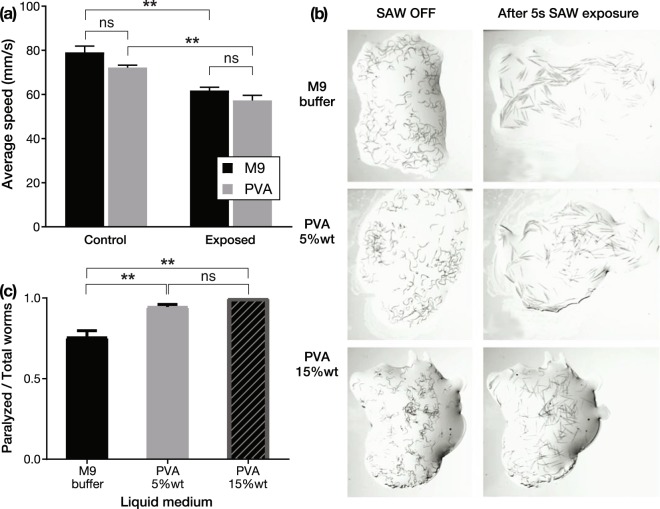Figure 4.
To determine if cavitation is a factor in the observed reduction in C. elegans’ motility, we exposed the worms to 10 s of 500 mW 20-MHz SAW in droplets of either polyvinyl alcohol or M9 solutions in the chamber configuration (see Fig. 1(a,b)). Polyvinyl alcohol, as prepared, is far more viscous than the M9 buffer solution with a consequent reduction in any ability to induce cavitation. The (a) effects of the SAW on the worms’ average speed in the two solutions were statistically identical (ns, p > 0.5), whether exposed to SAW or not. For (a), significance was based upon a two-way ANOVA upon data from independent experiments for the control and for the SAW-exposed worms, with n = 150–200 worms tested in each experiment, defining **p < 0.002. By increasing the SAW power to 1500 mW and switching to the (b) free fluid film configuration (see Fig. 1(c)), many of the worms were found to be paralyzed after only 5 s exposure, whether in M9, PVA 5% wt, or PVA 15% wt solutions. The (c) ratio of paralyzed to total number of worms in each experiment shows that switching from the less viscous M9 to the more viscous PVA produces a significantly (**p < 0.01) greater amount of paralysis, with insignificant (ns, p > 0.5) differences in paralysis between 5% wt and 15% wt solutions of PVA. Significance was based upon a two-way ANOVA upon independent experiments for each of the three liquid media choices, with n = 100–150 worms tested in each experiment, where ns implies p > 0.05, *p < 0.05, and **p < 0.01. In both (a,c) experiments, the normality of the data was assessed using the Shapiro-Wilk test with *p > α = 0.05 indicating the data were normally distributed.

